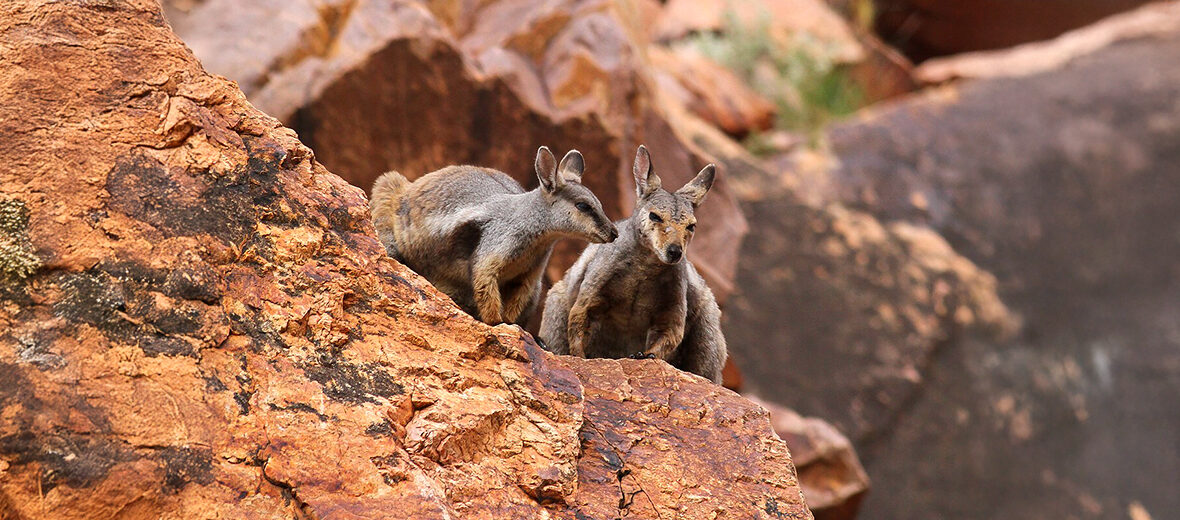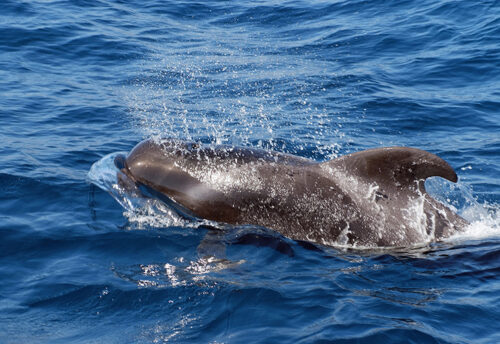
The black-flanked rock-wallaby, aka black-footed rock-wallaby, warru, or wiliji, is a shy and reclusive species of wallaby that hails from central and western Australia. These wallabies face the threats of habitat loss and destruction at the hands of farming, ranching, fires, and fire suppression; invasive species, that bring with them competition for food & predation; and climate change, that causes severe droughts. The IUCN lists these critters as Vulnerable. Their populations are also decreasing.
First the Stats…
Scientific name: Petrogale lateralis
Weight: Up to 9.3 lbs.
Length: Up to 22.4 inches, plus up to a 23.8 inch tail
Lifespan: Up to 12 years
Now on to the Facts!
1.) These wallabies were first described by John Gould in 1842.
2.) There are 5 subspecies recognized: Petrogale lateralis lateralis, Petrogale lateralis centralis, Petrogale lateralis kimberleyensis, Petrogale lateralis hacketti, and Petrogale lateralis pearsoni.
3.) Due to the fact that most of their water comes from the foods they eat, they rarely drink standing water and can conserve moisture by taking refuge from the heat in rocky caves.
4.) They are nocturnal (active at night).
5.) These critters live in small groups of up to 10 individuals.
But wait, there’s more on the black-flanked rock-wallaby!
6.) While being predominantly monogamous (mate for life), females will often mate with other males.
7.) This species features embryonic diapause. This is where the embryo’s development enters a state of dormancy until the environmental conditions are suitable for birthing.
Did you know…?
In 2014 there were approximately 8,000 wild individuals. As of 2024, there were only 100.
8.) Females undergo up to a 30 day gestation that yields a single joey.
9.) Unlike other wallabies and kangaroos, mothers will leave their joey (once it begins to leave the safety of the marsupium “pouch”) in a sheltered place while she feeds.
10.) They prefer mountainous areas with granite outcrops, sandstone cliffs, scree slopes (natural inclines covered with loose, angular rock debris that has accumulated at the base of a cliff or mountain), and hummock grasses (mounds formed by evergreen perennial grasses) with few available trees and shrubs, and they also dwell near coastal limestone cliffs.
But wait, there’s still more on the black-flanked rock-wallaby!
11.) Introduced red foxes, feral cats, and dogs, plus dingoes, all prey on these wallabies.
12.) Sheep and introduced European rabbits often out-compete these critters for available food.
Did you know…?
Previously widespread throughout the various ranges of central Australia, the warru is, as of July 2019, South Australia’s most endangered mammal.
13.) Native grasses, herbs, leaves, fruits, browse, and occasionally seeds are all on the menu.
14.) Previously listed as Vulnerable under the EPBC Act in 2009, since December 7, 2016. As of 2021 the wallaby is classed as Endangered (including all subspecies). It was also determined that they require a recovery plan.
15.) In August 2022, 25 warru that had been raised in the pintji, along with another 15 taken from a wild population, were subsequently released in the Everard Ranges, equipped with tracking devices for monitoring by the rangers. These were the first warru to inhabit the area in approximately 60 years.
Now a Short Black-Flanked Rock-Wallaby Video!
Be sure to share & comment below! Also, check out the Critter Science YouTube channel. Videos added regularly!

Want to suggest a critter for me to write about? Let me know here.
Some source material acquired from: Wikipedia & IUCN
Photo credit: Kym Nicolson



